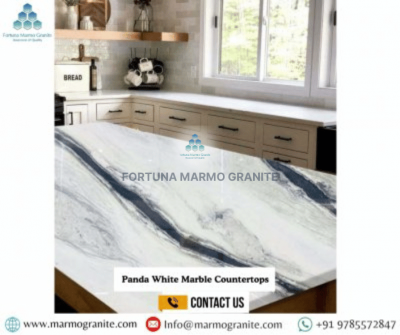Marble Countertop Care and Maintenance: Tips for Longevity and Preservation
Marble Countertops Supplier are a stunning addition to any home, bringing elegance and sophistication to kitchens, bathrooms, and even living spaces. The timeless beauty and unique veining of marble make it a sought-after material for homeowners who want to create a luxurious atmosphere. However, while marble is known for its aesthetic appeal, it is also a more delicate material compared to granite and quartz, requiring specific care and maintenance to preserve its beauty over time. By following proper care instructions, you can ensure that your marble countertops remain in excellent condition for years to come. In this blog, we will discuss essential marble countertop care and maintenance tips that will help preserve the longevity and beauty of your marble surfaces.
Understanding the Nature of Marble
Marble is a natural stone that forms from limestone subjected to high pressure and temperature over millions of years. This process creates the beautiful veining and patterns that marble is famous for. Each marble slab is unique, with variations in color and design, giving it a distinct appeal. However, this same natural formation process also means that marble is softer and more porous than other stones, like granite, and can be susceptible to damage from certain substances.
Marble is prone to scratching, staining, and etching, particularly from acidic substances such as citrus, vinegar, wine, coffee, and cleaning agents. Understanding these risks is important to help you take the right precautions and ensure that your marble surfaces retain their stunning appearance.
1. Regular Cleaning: The Foundation of Care
The first step in preserving your marble countertops is regular cleaning. Daily cleaning helps to remove dirt, debris, and any spills that could cause damage if left unattended. It's important to use the right cleaning materials and methods to avoid damaging the surface.
What You Need:
- Soft microfiber cloth
- pH-neutral cleaner or mild dish soap
- Warm water
- Soft sponge or sponge mop
How to Clean:
- Daily Wiping: Use a soft microfiber cloth to wipe down your marble countertops daily. A microfiber cloth is gentle on marble and helps to trap dust and debris, preventing scratches and smudges. Simply dampen the cloth with warm water, add a drop of pH-neutral cleaner or mild dish soap, and wipe down the surface.
- Deep Cleaning: For a more thorough cleaning, use a soft sponge or sponge mop to clean the surface. Avoid abrasive scrubbers like steel wool or harsh sponges, as they can scratch the marble and damage its surface.
2. Sealing Your Marble Countertop
Because marble is a porous material, it is highly susceptible to staining if liquids or oils penetrate the surface. Sealing your marble countertop is an essential step in protecting it from spills and stains. Sealing creates a barrier that prevents liquids from seeping into the stone and helps to maintain the surface's smooth appearance.
When to Seal:
Marble countertops should be sealed immediately after installation. After that, the frequency of resealing will depend on how often the surface is used. A general guideline is to reseal your marble every six months to a year, but you can also test the surface to see if it needs resealing.
How to Seal:
- Clean the Surface: Before applying sealant, ensure the countertop is thoroughly cleaned and completely dry.
- Apply the Sealant: Use a high-quality stone sealer designed specifically for marble. Apply a thin layer of sealant using a soft cloth or sponge, following the product's instructions for application.
- Wipe Off Excess: After applying the sealer, wipe off any excess using a clean, dry cloth to prevent streaking and ensure even coverage.
Let the Sealant Cure: Allow the sealant to cure for the recommended amount of time before using the countertop.
3. Protecting Your Marble Countertop from Stains
While sealing can help protect against stains, it's still important to take precautions to avoid spills and stains that may occur from everyday activities.
What to Avoid:
- Acidic Substances: Foods like citrus, vinegar, wine, and coffee contain acids that can etch and dull the marble surface. Always clean up spills immediately to prevent damage.
- Oil-Based Products: Oils, such as olive oil or greasy substances, can leave stains on marble surfaces.
Quick Tips:
- Use Trivets and Coasters: Always use trivets or hot pads under hot pots, pans, and appliances to prevent heat damage.
- Cutting Boards: Use a cutting board when chopping or preparing food to avoid scratching or etching the surface.
- Wipe Spills Immediately: Clean up any spills as soon as they occur to prevent staining or damage. For acidic spills, quickly wipe down the area with a damp cloth.
4. Polishing and Buffing Marble Countertops
To maintain the luster and shine of your marble countertop, occasional polishing is necessary. Polishing helps to restore the marble's natural shine and smoothness, enhancing its visual appeal.
How to Polish:
- Use a Marble Polishing Powder: Purchase a marble-specific polishing powder from a home improvement store. Follow the instructions on the product to apply it to your countertop.
- Buff the Surface: Using a soft cloth or a buffing machine (if available), gently buff the marble surface in small circular motions to restore its shine.
- Polish Once a Month: Polishing should be done sparingly, around once a month or when the surface starts to lose its shine.
5. Handling Scratches and Chips
While marble is a durable material, it can still be susceptible to scratches and chips. It's important to take proper precautions to avoid damage, but in case it happens, there are ways to address minor imperfections.
Minor Scratches:
For minor scratches, use a marble repair paste or marble polishing compound to fill in the scratch. These products can be purchased at most hardware stores and are designed to blend seamlessly with the marble surface.
Chips or Larger Damage:
For more significant damage like chips, it's best to consult a professional stone repair specialist who can fix the damage and restore the countertop to its original state.
6. Maintaining Marble Countertops in High-Use Areas
Marble countertops are commonly installed in high-traffic areas like kitchens and bathrooms. In these spaces, the countertop is exposed to daily wear and tear, making it more prone to stains and damage. Here are some additional tips for maintaining marble in high-use areas:
- Kitchen Countertops: In kitchens, marble is often exposed to food spills, hot pots, and acidic ingredients. Use a protective coating and ensure that the countertop is sealed properly. Clean up any spills immediately and use trivets, cutting boards, and placemats.
- Bathroom Countertops: In bathrooms, marble is exposed to soap, toothpaste, and other toiletries. Be sure to wipe down the countertop regularly and use a gentle cleaning solution to avoid damage.




